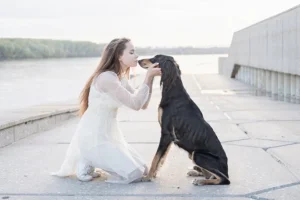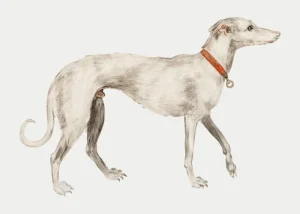Dealing with Greyhound Separation Anxiety
Greyhounds are one of the oldest breeds of dogs whose roots can be traced 8,000 years back. They are gentle and sweet-natured companions with an independent streak. First bred as a hunting dog, the greyhound is bred for racing in more recent times.
Being a racing dog, your greyhound has lived its life in the presence of other greyhounds. First with siblings and then in the presence of other racing dogs. When they are adopted into your home, it may be the first time they are alone. They do not take it well and can become distressed and also panic when left alone. This separation anxiety is dangerous for greyhounds. They can injure themselves in the process.
Our article takes you through everything you need to deal with concerning anxiety in your greyhound.
- Greyhound Separation Anxiety
- How Do I Stop My Greyhound from Having Separation Anxiety at Night?
- Do Greyhounds Mind Being Left Alone?
- Do Greyhounds Have Anxiety?
- Why Is Anxiety Common in Greyhounds?
- How Do You Treat Anxiety in a Retired Racing Greyhound?
- Crate Training for a Greyhound
- Conclusion
Greyhound Separation Anxiety
Greyhound separation anxiety is a common behavioral problem in a retired racing greyhound. A greyhound is a sensitive dog and can get attached to the pack or its family. Unfortunately, some can display anxiety, especially when you(family) leave or return home. Sometimes, it is caused by the owners when they fuss over the dog when leaving or returning. Dogs pick on the cues and start getting anxious when the pack leaves or returns home.
Crate training is a great way to teach your puppy to settle down and self-soothe itself in the crate.
Do All Greyhounds Have Separation Anxiety?
Greyhounds do not prefer being alone and hence can have separation distress. From the time they are born, they have company most of the time. First with their siblings and then with other greyhounds. So, being alone can be daunting for them. Your greyhound may need time and patience to assimilate to the current situation. Adopting or fostering another greyhound can help him to a great extent with the anxiety.
How Long Does it Take for a Greyhound to Settle?
Most greyhounds do not trust their new owner right away. And you may not see its personality for another few days. It can take anywhere between 3-5 days to get comfortable. However, the transition period is 4-6 weeks, by which time your new greyhound will adjust to its new life.
Keep in mind; the training starts as soon as you adopt your dog.
Where Should a Greyhound with Separation Anxiety Sleep?
Greyhounds with separation anxiety enjoy sleeping closer to you but not in the same bed. Prepare a comfy bed adjacent to yours and close the door. Do not allow them to roam at night. They are used to small places and can help your greyhound feel secure in them. However, avoid crates at night.
How Do I Stop My Greyhound from Having Separation Anxiety at Night?
Separation anxiety is one of the common behavioral problems in retired racing greyhounds. They generally sleep with their pack. Now that they are with you, you become their pack. And hence prefer to sleep with you at night. When that’s not possible, they have anxiety even when you are at home. They feel removed from the pack and become insecure.
Apart from that, the anxiety may also be due to underlying medical issues. For example, arthritis, noise phobia, and failing senses like sight and hearing can stress your dog causing anxiety.
As pet owners, you can follow the routines below to prevent separation anxiety at night.
- Allow them to sleep in the same room as you. However, rather than being in bed, place a dog bed closer to yours.
- Calming dog beds do wonders to provide a comfy sleeping spot for your greyhound. In addition, their donut shape provides safety and comfort to your greyhound.
- Using diluted oils can help the dogs to calm down and help them to go to sleep. For example, vetiver Lavender, Rose Hydrosol, and Violet Leaf help with separation anxiety.
- A bedtime treat can help an anxious dog wind down and get ready for bed. When making this, a regular habit can signify bedtime.
- Music can have a calming effect, like with humans. Classic and reggae music can help calm your greyhound, while white noise helps with noise phobia.
- A soft and cuddly toy can comfort them through their nighttime anxiety.
- A tired dog can fall asleep quite fast and in a deep sleep. Increasing the amount of exercise can calm the nervous energy at bedtime.
Do Greyhounds Mind Being Left Alone?
Your greyhound can do well when you are away at work. However, you cannot leave it alone for long periods. Therefore, you may want to hire a dog walker for your pet, at least in the beginning.
How Long Can a Greyhound Be Left Alone?
Greyhounds can handle being left alone much better than other dogs. The recommended time away from your dog is 6-8 hours and not more than that. Beyond this, your greyhound can become bored and lonely, leading to separation anxiety. Dogs with extreme separation anxiety may indulge in destructive behaviors. Chewing, digging, and excessive barking are not uncommon. Few may also urinate within the living quarters.
Do Greyhounds Have Anxiety?
Anxiety is widespread among greyhounds, both racing and retired. As a result, almost 60% of the dogs have been returned to the shelters with issues related to the same. They also account for 90% of the referrals to veterinary behaviorists.
How Do You Deal with Greyhound Separation Anxiety?
Understanding anxiety is the key to dealing with an anxious greyhound. Above all, you need to recognize the signs of an anxiety attack and remove them from the situation. Unfortunately, the most common reaction to the triggers is to freeze with a glazed look.
Instead of ignoring your dog’s fears, acknowledge them and stay calm and collected. It shows your dog that there’s nothing to be scared of. And, do not force it into scary situations. This tends to make the situation worse and can escalate into aggression.
Start with controlled exposure to a wide variety of low, threatening sounds and experiences that can help your dog. However, this has to take place when it is calm and not in stress.
What Helps an Anxious Greyhound?
As a rehomer, you need to understand anxiety and its consequences in everyday life. Hence, a behavioral assessment is vital for a greyhound adoption program. This is to ensure that you are aware of the temperament of the greyhound and its limitations.
To start with, ease your greyhound to new surroundings with controlled exposure and not in an off-leash park. Painful conditions and illnesses also contribute to anxiety. Hence, take your greyhound to a veterinarian for an assessment. It can be anything from dental pain to spinal pain and even arthritic conditions.
How Do You Calm an Anxious Dog?
Learn the signs of anxiety and its triggers can go a long way in helping your greyhound. But, first, remove them from circumstances that cause fear.
Here are a few other things you can do to calm your greyhound.
- Use exercise as a bonding session with plenty of physical contact. Also keep talking to them. Anxiety can create excessive energy in your greyhound. Taking your dog for long walks or out for playing can tire him out.
- Much like human beings, a soothing massage can help them calm down and relax. Keep one hand on him at all times while you massage with the other.
- Isolate your dog in a calm and quiet place, if possible in his crate. You can also play some music with low lights and aromatherapy.
- Spray “Rescue Remedy” on to soothe your dog. It’s a combination of scents that relieves stress and creates a calm environment for pets.
- An anxious dog can benefit from a calming coat to a large extent. It gives a constant soothing pressure on the torso, which can help calm the dog.
- Above all, your physical touch can go a long way in calming your dog when acting stressed.
Why Is Anxiety Common in Greyhounds?
Understanding greyhound separation anxiety helps you go a long way to understand your dog better. You can also handle the animal better during nerve-racking situations.
Early conditioning, socialization, and acclimatization are vital for normal social development. They also need to be exposed to new and distinct things in the first year of a dog’s life. But in the case of a greyhound, it is raised in paddocks with minimal human intervention for 12-15 months. They are also devoid of everyday household sounds and sights that other dogs take for granted in this period. Furthermore, they do not experience any human touch. This makes the transition quite difficult for the dog.
When retired, they are thrust into a domestic environment and lose their structure. On top of that, rehoming is quite tricky and stressful for any dog. This can manifest as fear and anxiety. Post-traumatic stress can result in extreme fear may also result in anxiety in a greyhound.
On a final note, the genes also decide how much anxiety a greyhound has. Diseases and anxiety are inherited and can be passed down through parents or their pups. However, when seeking speed and strength, these tend to be overlooked.
How to Recognize Greyhound Separation Anxiety
Anxiety is the constant anticipation of fear which may or may not be real. The dog will be in a constant state of turmoil. This can be exhausting and affect the judgment over time. Unless they are terrified, your greyhound can exhibit subtle signs of anxiety. However, being undetectable they are often ignored.
Here are a few signs that a greyhound may exhibit in times of anxiety:
 Licking lips (anxious dogs have a pink-stained muzzle)
Licking lips (anxious dogs have a pink-stained muzzle)- Whining
- Fight or flight response
- Yawning
- Freezing or shutting down
- Hiding
- Hypervigilance
- “Velcro dog” behavior where the dog follows you everywhere
- Tail tucked low and tight
- Destructive behavior
- Restlessness
- Growling and biting
- Lack of appetite
- Chronic diarrhea
How Do You Treat Anxiety in a Retired Racing Greyhound?
Unlike other dogs, greyhounds have an unusual upbringing. They stay with their littermates for a good portion of their first year. Then, at one year of age, they go for training. By 15 months of age, they move to a race track. When in training or a racing kennel, these dogs are surrounded by other greyhounds.
Once they retire, for the first time in their lives, they are alone. So, it makes perfect sense to have behavior problems and anxiety. However, with careful handling and training, you can treat the anxiety.
- Crates: Your greyhound has been in a crate for the better part of its life. Crates can protect your dog and your home from him. In the same way, place your dog in his crate 15 minutes before you leave home. It helps him to settle in.
- Reward calm behavior: Wait until your greyhound is calm and collected before you let him out. Do not let your arrival home be the most exciting part of the day for him. Do not talk or pet or cuddle him when he is anxious.
- Treat dispensing toys: Make his mealtimes more interesting by including food puzzles. This way, he can have a positive experience even you are not home.
- Kong toy: Frozen kong toy filled with peanut butter can keep the dog busy. You can also replace it with bully sticks, chew toys, or bones that can keep him busy. However, you may want to adjust his meal timings and amount.
- Watch your tone: The high-pitched squealing tone of your voice when you come home creates excitement.
- Supplements: Dog treats packed with supplements can help manage anxiety.
- Medical intervention: Medication can help your greyhound to relax. He can gain control of himself and also unwind when alone.
Crate Training for a Greyhound
Greyhounds are used to living in crates with other dogs. As a result, they find crates safe and secure. On the other hand, the regular sounds and smells of your home are rather new and stressful. They may find a crate safe and secure. In addition, frequent use of a crate can help the transition easier for a new dog.
To start with, introduce him to the crate in short periods. And then, as the days go by, increase the time he spends in it. Let it be his personal space. Ensure that you feed him in his crate. Let the dog stay in the crate when he is excited. Do not let him out when he is making noise.
However, for many dogs, particularly those with anxiety, being in and out of a crate can be stressful. As a result, they may try to push or chew their way out of the crate. In this case, a large wire crate can keep your new greyhound safe unsupervised. It should be big enough to allow him to stand upright, turn around, and lay down in a comfortable manner.
Should Greyhounds Sleep in a Crate?
Yes! Greyhounds can sleep in a crate at night as long as he is crate trained. Moreover, he should have enough out-of-crate time during the time. Do not forget a potty break before they go to sleep. Many greyhounds prefer to sleep in one, enjoying the safety it provides.
How Long Should I Crate My Dog?
As a general rule, do not confine your greyhound in its crate for more than 8 hours. If you are crating it for more than 8 hours, you need to have a dog walker come in to walk him. Older dogs and puppies need more frequent breaks. In case you are crating him at night, ensure that they have enough time outside the crate. You can consider a doggy daycare or a pet sitter as an alternative.
You can leave a crate-trained dog with the door open so that he can come and go as he likes. This allows him to be comfortable in his den-like environment.
Conclusion
 It is natural for you to ensure that your greyhound has a wonderful place to live with enough toys and great food. However, it is not enough for your dog. Greyhounds, in particular, need direction and boundaries. This will give the dog a sense of security in his new environment.
It is natural for you to ensure that your greyhound has a wonderful place to live with enough toys and great food. However, it is not enough for your dog. Greyhounds, in particular, need direction and boundaries. This will give the dog a sense of security in his new environment.
Most dogs experience some kind of anxiety at some point in their lifetime. Being aware of the anxiety-inducing situation can help you better handle your greyhound. Exercise, soothing music, and a full belly can help a greyhound with its anxiety.
Crate training can also help your dog with its anxiety since it mimics a den-like environment. For a crate-trained dog, it is a safe and secure place where he likes spending time. In fact, many dogs prefer sleeping in crates at night where they can enjoy relative safety.

